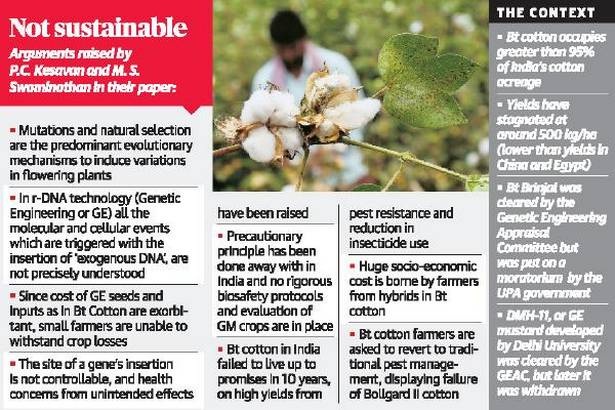
M.S. Swaminathan calls GM crops ‘a failure’
Why is it in news?
- A research paper co-authored by leading agriculture scientist M.S. Swaminathan, which describes Bt cotton as a ‘failure,’ was criticised by India’s Principal Scientific Adviser (PSA), K. VijayRaghavan as ‘deeply flawed’.
- The article is a review of crop development in India and transgenic crops- particularly Bt cotton, the stalled Bt brinjal as well as DMH-11, a transgenic mustard hybrid.
- The latter two have been cleared by scientific regulators but not by the Centre.
More in news
- The piece also raises questions on the genetic engineering technology itself on the grounds that it raises the cost of sowing.
- Also, the insertion of foreign genes (in the plant) could lead to “molecular and cellular events not precisely understood.”
- Prof. Swaminathan, credited with leading India’s Green Revolution, has in recent years advocated ‘sustainable agriculture’ and said the government should only use genetic engineering as a last resort.
- Swaminathan emphasised that genetic engineering technology is supplementary and must be needbased.
- Only in very rare circumstance (less than 1%) may there arise a need for the use of this technology.
- Conventional GE technology-
- It uses genes from soil bacterium to either protect them from specific pests or— as in the case of GE mustard — facilitate hybridisation.
- This means making the plant more amenable to developing higher-yielding varieties.
GM Crops
- GM is a technology that involves inserting DNA into the genome of an organism.
- To produce a GM plant, new DNA is transferred into plant cells.
- Usually, the cells are then grown in tissue culture where they develop into plants.
- The seeds produced by these plants will inherit the new DNA.
- The genetic makeup of an organism is its genome, which in all plants and animals is made of DNA.
- The genome contains genes, regions of DNA that usually carry the instructions for making proteins.
- It is these proteins that give the plant its characteristics.
- Genetic modification of plants involves adding a specific stretch of DNA into the plant’s genome, giving it new or different characteristics.
- This could include changing the way the plant grows, or making it resistant to a particular disease.
- The new DNA becomes part of the GM plant’s genome which the seeds produced by these plants will contain.


